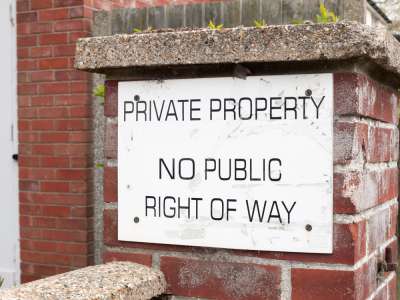
No right of way to access my home – what can I do?
When buying a home, it is the buyer’s responsibility to find out as much as possible about the property before exchanging contracts and legally committing to the purchase. You should always check that you have a legal right to access your property. It is reported that there is estimated to be more than 40,000 unadopted roads in England and Wales.
Your solicitor will conduct a local search on the property to obtain information about it held by the local authority. Local Searches reveal lots of information about a property, including whether a public footpath crosses the property and whether the road it is on is ‘adopted,’ i.e. maintained at public expense. An adopted road is a road over which public rights of passage exist, which means that the public can pass and repass without any hindrance or charge. An adopted road can be used on foot or driven over with a motor vehicle. If a road, footway or footpath is not adopted, you may have no right to use it, and therefore you may not have any legal right to access your home.
A public footpath is a right of way over which the public has a right of way on foot only. In the absence of any private agreement or authority from the landowner, it is an offence to drive over a footpath. So if the main access way to your property is a country lane designated as a footpath, you will be committing an offence under the Traffic Act 1988 every time you go to or from your property.
How can I access my home if the road is not adopted?
If the road is not adopted, there may be private rights of access, either on foot only or on foot and with vehicles, granted to your property in the title. If a right of access has been legally granted then, it will not be an offence to use the road.
If the road is not adopted and there are no legal rights of access granted, you may still be able to demonstrate that a legal right of access has been acquired by ‘prescription’. This is at least 20 years of use without the consent of the owner of the land. Prescriptive rights are evidenced by a Statutory Declaration (a legal document) made by an individual or a number of individuals, i.e. successive owners of the property, to confirm their use of the access over a period of at least twenty years.
If the road is not adopted, there are no rights of way granted, and a prescriptive right cannot be shown, then you should obtain an indemnity policy for a lack of right of way.
If you are obtaining a mortgage, the lack of right of access should be reported to your lender to check that the valuation isn’t affected.
Who will be responsible for the maintenance of the road?
An adopted road is maintained at public expense by a council. A road that is not adopted will require the individuals who use it to repair and maintain it, so the cost of this is something you should bear in mind. Sometimes, residents associations are set up to deal with these works and collect contributions. It is also the case that unadopted roads can go without repair and maintenance if individuals are not prepared to contribute financially and arrange the work. Again, this is something you should consider.
Here to help
If you have any more questions or would like more information regarding right of way, you can contact our Residential Property Team below.






